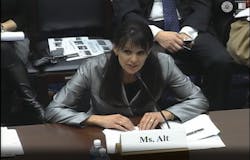Increasing the national standard for twin trailers to 33 ft. from the existing 28 ft. would allow carriers to absorb up to 18% of future freight growth without any change in gross vehicle weight or additional miles traveled on roadways, the chief executive officer of FedEx Ground told a Congressional subcommittee Feb. 27. The House Transportation & Infrastructure Committee’s subcommittee on highways and transit is holding a series of hearings related to highway funding and safety as it works to reauthorize those programs. The current act, known as MAP-21, expires Sept. 30.
Testifying before a hearing on the nation’s freight network, Henry Maier, CEO of FedEx Ground, told the subcommittee that projected benefits of allowing 33-ft. twins are based on data supplied not only by FedEx, but also ABF System, Con-way, Estes Express, Old Dominion Freight Line, UPS and YRC Worldwide.
“Industry-wide, that equals up to 1.8 billion fewer miles driven, more than 300 million gals. of gasoline saved and $2.6 billion in reduced costs annually,” Maier said. “Importantly, a reduction in truck trips would be environmentally friendly, saving fuel and emissions from trucking. This is an excellent example of an innovation that can have tremendous value – including increasing cost efficiencies – but it is one that cannot be implemented without Congress modernizing our transportation policy.”
Some states allow the larger trailers, and FedEx has been testing them in Florida since 2010, Maier told the subcommittee. Not only have the larger trailers been just as safe, but also some drivers operating them believe safety is enhanced because the longer combination is even more stable than those with 28-ft. twins, he said.
Deterioration of highways and bridges “is fast reaching crisis proportions,” Maier said. “As a business whose customers rely on us for fast and reliable service, we can attest that impassable roads and bridges lead to increased costs, service delays and untold equipment damage.”
Maier noted that MAP-21 calls for the identification of a 27,000 mi. Primary Freight Network comprising highways viewed as essential to the delivery of goods. This measure is inadequate given that the Federal Highway Administration says that more than 41,000 mi. of highways would be needed.
“While FedEx agrees in principle with the Primary Freight Network concept, we have concerns based on its limited scope,” he said.
FedEx agrees with the American Trucking Assns. call for greater emphasis to be placed on critical freight corridors and intermodal highway connectors.
Highways’ importance for manufacturers
The Volvo Group North America told the subcommittee that the health of America’s freight network matters to the company not only because of its importance to Volvo customers and their need for equipment, but also because it directly affects the competitiveness of Volvo’s American manufacturing operations in the global economy.
“Like any other manufacturer, we rely on a vast supply chain and our nation’s interconnected network of roads, airports, inland waterways and ports to support and supply our operations,” said Susan Alt, senior vice president for public affairs for Volvo Group North America and former head of the company’s North American supply chain operations.
“Just in time” and lean manufacturing philosophies in recent years have benefited Volvo, its customers and the overall economy, Alt noted. “However, to be efficient we must have the right material, at the right time, at the right place, and in the exact amount needed in the production cycle.”
While the company can plan for some uncontrollable events that impact delivery times, it can’t plan for unexpected delays due to traffic congestion, Alt told the subcommittee. “This is where we get in real trouble - when a truck is caught in a traffic jam and can’t make his delivery. The ripple effect of one late delivery can be costly. It means we don’t build the product on time – tying up capital; it means the product will be re-worked – tying up man-hours and not following normal quality production; it means sending workers home early; it means not delivering to a customer on time and hurting our competitiveness…all because of that one missed shipment.”
While transportation infrastructure is serving the supply chain adequately today, it’s not well-positioned for the future, Alt said. “Highway infrastructure continues to age without a systematic program to modernize key interstate networks; traffic is returning to peak levels that we have not experienced since before 2008 and we are gradually experiencing economic growth with a strong emphasis on exports.”
MAP-21 represented an important step toward reforming transportation policy, but “a full six-year, well-funded reauthorization is needed to address the persistent challenges that are already well-documented and recognized as problems facing our transportation system,” Alt told the subcommittee.
A critical concern is traffic congestion, Alt said, sharing one example from Volvo’s experience at its southwest Virginia plant located along I-81. Until a third truck lane was added, a stretch of mountains near Blacksburg, Va., was the site of many accidents, resulting in frequent delivery delays and production disruptions for the plant, she said. “Since the opening of the third lane, we have a marked improvement in on-time deliveries from that route. This is a real world savings that directly benefits our customers, as well as the safety of the driving public.”
Other witnesses at the hearing were Wisconsin Department of Transportation Secretary Mark Gottlieb, testifying on behalf of the American Assn. of State Highway and Transportation Officials, and Palos Hill, Ill., Mayor Gerald Bennett, testifying on behalf of the Chicago Metropolitan Agency for Planning.





